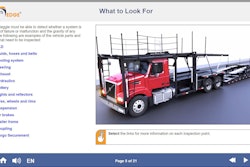There are thousands of leaders in the trucking/logistics industry, regardless of their exact title.
When I was a regional manager for Horton I had to give a report on the status of my region to top management. The template for the report was typical: review sales, distributor marketing efforts and what the competition was doing.
In what became known as a “typical Bob Rutherford” move, I added a special projects section to my presentation. One special project, which was cutting-edge back in the day, was offering fleets both upfront warranty parts and the training of a special fleet technician (whom I personally certified) to handle warranty claims on the spot and use parts from the upfront warranty stash he kept in his toolbox.
At the end of the presentation, the company president said, “Bob, I have one question for you. Who gave you the authority to start this special project of yours?” I looked at my two bosses, they looked at each other, and then one of them said, “I guess he just took it.”
Was what I was doing leadership?
Management even had some lawyers make sure my use of the word “certified” didn’t put the company on the hook for more liability than necessary. The lawyers basically said, "If you trust Bob to train them, then you have to trust Bob to certify that he has made them certified."
The lawyers asked me, “Are you teaching them and testing them?” I was. The lawyers told management, “You’re good to go.”
I ordered 1,000 baseball caps that said “Certified Technician.”
They wanted to know, “How the hell are you going to train 1,000 technicians on fan clutches?”
“Two ways," I responded. "I’m going to get started right away and, second, I’m going to show you why we need to start a training department to help me.”
The funny thing about this whole story is the trained troubleshooters only once filed a warranty claim for a defective a fan clutch. There was always a root cause of the failure. A leaking air line, a loose solenoid wire or a defective air conditioner switch all could be one of many a root causes of a fan clutch failure.
The one legitimate warranty claim was for “wood chips found in bearing grease," but that’s another story for another time.
Another complicating issue that made a fan clutch salesperson’s life hell is affectionately referred to as “progressive damage”. In other words, if a $100 sensor, switch or other product fails and causes $3,000 of damage to other components such as the fan clutch, the fan and the radiator, the fleet only recovers the $100 for the cost of the defective product, not all the products that were “progressively” damaged.
Fan clutches are relatively simple compared to many components on a truck. However, as the fan clutch interfaces with the highest maintenance components on a modern day truck it becomes one of the most difficult devices to keep properly operating.
The fan clutch is part of most, if not all, these systems on a commercial motor vehicle: Cooling system; compressed air system; air conditioning system; electrical system; and charge air turbocharger system.
A minor failure in one of these truck systems (like a switch/sensor or loose wire) can create conditions for the fan clutch to fail. The mechanic troubleshooting a failure has to be able to think and have a deep knowledge of all the systems to properly troubleshoot the root cause to in order to not have the replacement clutch fail.
What if the fan clutch has an air line leaking, a loose solenoid wire and an air conditioning switch over cycling the fan clutch, but the mechanic only finds each of these root causes one at a time? That will lead to three root causes and three fan clutch failures. One mechanic fixes the air leak and puts a new clutch on and the fleet puts the truck back on the road. Next week, another mechanic finds the solenoid wire that causes the replacement clutch to fail. Six months after that the wear and tear of the defective air conditioning switch is uncovered. Another non-warranty failure.
Here’s what I see in the future for all air operated fan clutch companies: an artificial intelligence troubleshooting system specializing in fan clutches. Before going through the expense of sending out a human troubleshooter, send out a virtual AI & ML troubleshooter. The mechanic plugs the Tangerine.ai unit into the vehicle data bus, installs a TE Connectivity air pressure sensor on the fan clutch side of the solenoid, opens the troubleshoot internet portal and can make human observations at the portal (something most humans can’t wait to do, even though they don’t have to), or wait for the system to start sending email alerts every time a discrepancy from normal is detected.
Is what I am doing what leaders (regardless of title) should be doing? Am I doing what Dr. W. Edwards Deming said management and leaders should be doing, predicting the future, or in his words “management is prediction."
Based on my experience troubleshooting fan clutches, I would recommend the trucking industry start using this AI system – let’s call it the “Fan Clutch Failure Analysis Tool” – on vehicles having repeat fan clutch failures, or a fleet having one truck after another fail at about the same time.
Here are a series of partnerships I personally predict as happening in the near future to make “the tool” available both quickly and inexpensively. Remember, “management is prediction”.
• Tangerine.ai partners with TE Connectivity to select the perfect air pressure sensor for every combination of OEM truck and fan clutch manufacturer. Then, Tangerine partners with OEM fan clutch suppliers and Kit Masters' aftermarket program to make the “Fan Clutch Failure Analysis Tool” available to the trucking industry aftermarket.
In a conversation with Al Roberts at Turbo Diesel and Electric Systems in Forest Park, Georgia, he suggested the AI system could also troubleshoot electrical systems. He suggested the AI system be connected to a Midtronics BMS-300 electrical monitoring system for troubleshooting. This is something he will be considering in the future to help his customers who experience unexplained repeat failures on electrical components, such as batteries and alternators.
• I also see a partnership between Tangerine.ai and Viaduct.ai to make a version of the tool available to OEM truck builders as Viaduct.ai develops more partnerships at the OEM level to provide sophisticated artificial intelligence and deep learning capabilities in the world of predictive maintenance.
• I also see truck OEMs being included, making the tool available to dealers nationwide as they partner with predictive maintenance AI & ML companies like Viaduct.ai.
One of the aggravations of running a SAE/TMC type II fuel economy test is having to deal with a variable like a fan clutch cycling on and off during fuel consumption testing. A typical fan clutch on a commercial truck can consume up to 10% more fuel. Fans don’t cool for free.
The normal procedure in conducting a SAE/TMC type II test is to lock the fan in the on position. This is hard on the fan clutch, and in the winter it is hard on the engine. It also is not the “real world” test a fleet manager would like to see. I have presented fleet managers SAE/TMC fuel consumption studies and received the comment, “Bob, I don’t run my trucks with the fan clutches locked in, so how do I know this applies to my trucks?” So many times I wanted to say, “Because a lot of people smarter than you say so!” But I didn’t. My first sales manager told me, “Bob, win the sale, not the argument.” So, I never did get that off my chest until right this moment.
My last column was about developing a type V fuel economy test that will eliminate the fan clutch as a variable. The fuel economy test needs the run time of the fan clutch if not locked in the on position. The tool we are talking about provides that run time. This allows the testers to actually turn on the fan clutch that is running the least, or mathematically adjust for the extended run time of the clutch.
The reason I bring this up in an article about troubleshooting fan clutches is excessive run time can cause premature fan clutch failure.
I once had a fleet running two different OEM trucks. On one brand truck the fan clutches barely made it out of warranty before failing. The other truck never had a failure during the same time frame – not even a random failure.
My root cause analysis: a six gallon difference in cooling systems between OEMs killed the fan clutches, amazingly, just out of warranty.
Was that the plan from the beginning by the OEM? A smaller, lighter cooling system at the cost of a fan clutch? Six gallons is about 50 pounds of weight. After all, commercial motor vehicles are one compromise after another. Fleets want lighter trucks and want the fan clutch to live the life of the truck, at least for the first owner.













